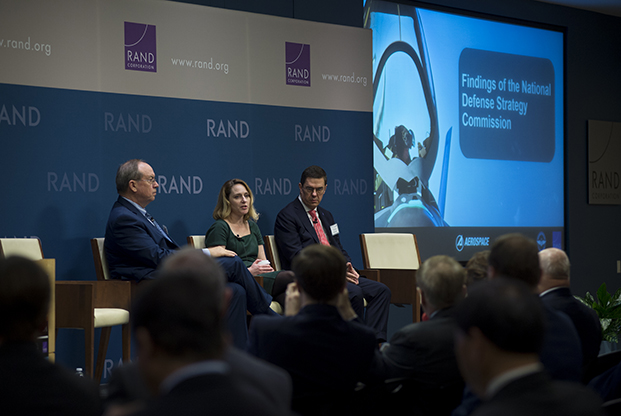
Retired Air Force Lt. Gen. Dave Deptula discussed his findings with commission members and leading D.C. think tank experts Kathleen Hicks and Thomas Mahnken at the forum. RAND Corporation photo by Diane Baldwin.
The threats to US national security are greater than they have been in decades and the United States can no longer afford to push off mounting modernization costs, said two members of the National Defense Strategy Commission at the West Coast Aerospace Forum in Santa Monica, Calif., last week.
In its final report, released late last month, the Commission urged Congress to increase the base budget at an average rate of 3 to 5 percent above inflation over the next five years, clearly warning that without additional funds the US “might struggle to win, or perhaps lose, a war against China or Russia.”
Yet, the White House has directed the Pentagon to cut the Fiscal 2020 budget by $33 billion, or roughly 5 percent from fiscal 2019, which retired Lt. Gen. Dave Deptula, dean of AFA’s Mitchell Institute, recently argued in a Forbes column would negatively impact the Defense Department’s efforts to rebuild “capabilities worn thin by decades of constant combat.”
Deptula discussed his findings with commission members and leading D.C. think? tank experts Kathleen Hicks and Thomas Mahnken at the forum.
The commissioners agreed that more resources for defense are crucial, saying the additional funds should be directed toward the development of new operational concepts, technological innovation, and building focused strategies to best address the mounting challenges facing America.
“We have been on the wrong end of cost curves over the last several years. There are opportunities to force our adversaries to deal with disadvantageous circumstances or change the game through innovation along the lines of what stealth afforded at the end of the Cold War,” said Mahnken.
Hicks said the time has come for the Defense Department to get serious about progress. “In the past, we thought we had time, so we pulled money from long-term investment and focused on the near-term priorities. The problem is that the modernization challenge is now, with a drive towards asymmetry and a more relevant strategic alignment.”
Both panelists also commended the National Security Strategy’s clear focus on direct threats.
“It is commendable that the National Defense Strategy is naming names, this was not always the case,” said Mahnken. “It allows us to focus on direct challenges, while also driving energy and investment.”
The West Coast Aerospace Forum was hosted by AFA’s Mitchell Institute, the RAND Corporation, Aerospace Corporation, and the Center for Strategic and International Studies.